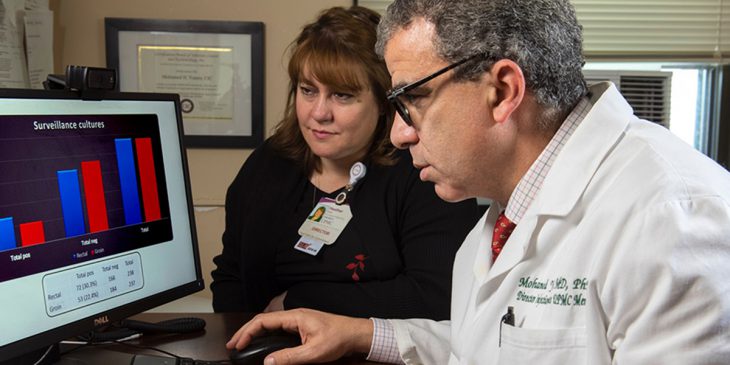Staff in intensive care units (ICU) have seen it all. They provide the compassionate, expert care our most complex patients need. It’s rare to find an issue that makes this group nervous – except when it comes to bacteria.
“Multidrug-resistant organisms (MDRO) are the ICU’s worst nightmare,” said Dr. Mohamed Yassin. “These organisms have very limited treatment options and carry a high mortality risk.”
What’s worse, is that these bacteria can spread easily, whether through contact with the environment or an infected patient. That means, when one patient is infected with a MDRO, it can become a problem for everyone in the hospital. So how can we protect our patients and frontline workers from these organisms?
Yassin had an idea.
Looking at Things Vertically
 “Surveillance is the best way to control infection,” Yassin said. “When you’re trying to prevent problems, you have to know how many patients have what kind of infection.”
“Surveillance is the best way to control infection,” Yassin said. “When you’re trying to prevent problems, you have to know how many patients have what kind of infection.”
Most hospitals perform vertical surveillance, meaning everyone is tested for one or two specific bugs when they enter the hospital, no matter your illness, history, condition or any other factors.
Through his work, Yassin came to realize that although staff were testing patients for MDROs, the methods weren’t perfect. Screenings didn’t seem to necessarily predict whether patients would develop a MDRO infection while they were in the hospital.
“We’re always searching for how we can gather more effective information about our patients,” he said. “You always think if you had known some information ahead of time, you could have better protected the patient against certain infections. That’s how this idea came to mind.”
Yassin’s idea is simple. What if instead of testing all patients for a limited number of bacteria, doctors only tested patients who are more likely to have an infection for a wider range of bacteria?
With that, a Frontline Innovation idea was born.
A New Perspective
Yassin’s idea is called horizontal surveillance – taking a slice of the patient population who are more likely to develop an infection and testing them for MDROs that can cause infections. This method not only greatly diminishes the number of tests administered, but also gives the caregivers a better idea of the patient’s risk of developing infections, which in turn allows them to take appropriate steps to protect the patient.
Yassin received his first Frontline Innovation grant from The Beckwith Institute to test his idea in 2016. He aimed to prove that horizontal surveillance was more cost effective than its vertical counterpart, and more effective at preventing infection.
 As the project progressed, he developed a team at UPMC Mercy to help test his idea. Heather Dixon, MSN, director of Quality, Safety and Patient Experience at UPMC Mercy, was one of the people to jump on board.
As the project progressed, he developed a team at UPMC Mercy to help test his idea. Heather Dixon, MSN, director of Quality, Safety and Patient Experience at UPMC Mercy, was one of the people to jump on board.
“We’re trying to get a little bit more focused and a little bit more targeted,” Dixon said. “But, I think the unique thing about this project is the engagement of the critical care leaders and staff.”
That’s where the teams led by Raquel Felix, MSN, unit director of medical ICU, and Brett Mohney, BSN, unit director of medical-surgical ICU, come in. It didn’t take much convincing to get them involved with the project.
“We wanted to participate in the project because it’s an opportunity to pursue a higher level of patient safety and quality,” Mohney said. “There’s also an element of ensuring safety for our staff. Knowing what precautions are necessary for these patients helps keep patients safe, and it helps keep staff safe.”
Every morning, Felix and Mohney’s units are notified if their patients need to be swabbed. Together with the clinicians, including Judy Miller, BSN, Alex Stynchula, BSN, and Brandon McEwen, BSN, they take samples from the patients and get them to the lab later that morning.
So far, the results have been positive. Yassin and his team’s preliminary findings show that this new method of surveillance is more cost effective. They’ve also been able to show that high-risk patients are likely to have more than one MDRO, information that allows their care teams to better manage the infections and protect themselves.
“Based on the preliminary results, I think this will definitely change practice,” Felix said. “We will be moving into the next step of the clinical trial and implementing this for all of our patients.”
Expansion on the Horizon
Yassin and his team received another Frontline Innovation grant from The Beckwith Institute for 2019 to continue their work. His goal this time is to further verify their findings, with the hope that he’ll be able to bring this method of testing to all UPMC facilities and beyond.
“I couldn’t have done anything with this project without the Frontline Innovation grant,” Yassin said. “I encourage a lot of people to apply. This kind of grant has helped me personally. You make a proposal, aim, goal, methods, you have a budget, and you work through a process that’s stringent and accurate, so it’s definitely a wonderful idea.”
Including Yassin’s project, 14 proposals received the Frontline Innovation grant for this year. Stay tuned for more features on the Frontline Innovation ideas that are changing perspective of patient care and beyond.








